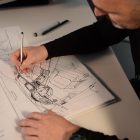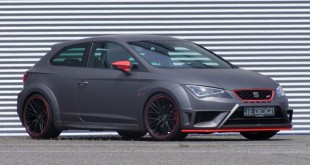
Ever wondered how the car on your driveway comes into being? Spanish car manufacturer, SEAT has the answer as the company releases a step-by-step look at the design process at creating its new Ateca SUV.
Like almost all design process, it all starts with good old fashion pencil and paper but here are some interesting figures: 1,400 days, more than 1,000 sketches, 5,000 kilos of clay and 1,000 litres of paint. This is a four-year process that begins with the handiwork of an artisan, using pencil and paper, and ends with a finished vehicle on the assembly line. Along the way, life-size clay vehicles are made, new colours and textures are created and the interior of the new car is defined.
- To begin with, the guidelines of the new model are drafted and approved. They form the roadmap that will define the car’s DNA, so the entire process must follow these indications.
- The designers can now start producing preliminary sketches of the new car. Early versions reflect “what we would like it to look like”, says Jaume Sala, head of Interior Design at SEAT, ending up with an image of the new vehicle that is “picture perfect”. Over the course of four years they produce over 1,000 sketches.
- Generating the computer-assisted design. Once the sketches are made, they are recreated digitally to give volume to the future vehicle. Not only does the document serve for the design of the new car, it is also used for its technical monitoring.
- Clay model. This life-size model weighs four tonnes, twice that of a conventional car. It serves to physically recreate the exterior design, and it is constantly shaped to accommodate modifications. This process also involves the handiwork of a master craftsman who smooths and shapes the model by hand.
- Frozen model. This is the definitive exterior design that is approved by the company. It looks completely real, even though it is still a clay model. Up to 5,000 kilos of clay can be used throughout the entire process until it is frozen.
- Creating colours. The Colour & Trim department is in charge of creating the colours used on the interior and exterior of the new model. Their work begins two years in advance by gathering ideas that stem from new developments in “the areas of fashion, architecture or product design”, explains Jordi Font, who is responsible for this department at SEAT. Even though they carry out 100 formulations and use 1,000 litres of paint, ultimately only 12 tones will make it to the colour chart for the exterior of the car.
- Aspects concerning “comfort and good looks”are carefully considered when developing the car seat, assures Jaume Sala. The Colour & Trim department is also involved in this part of the process; they use a sewing machine to prepare patterns “that combine the most suitable fabrics and colours”, says Jordi Font.
- Interior design. “Everything is driver-oriented”, stresses Sala, who also explains that the protagonism of the touchscreen is such that first they decide where to place it and all the rest is secondary. The design of the interior is especially governed by functionality. “We ask ourselves where it would be most convenient to store a mobile phone, glasses or a bottle of water”. For this reason, he concludes, the design has to be “useful and efficient”.
The end result of all these simultaneous processes is a brand new model. After four years of intense work, the design team is still going strong as a new project is already in the pipeline.
 ForceGT.com Car News, Car Reviews, Video Reviews, Tuning and much more.
ForceGT.com Car News, Car Reviews, Video Reviews, Tuning and much more. 















